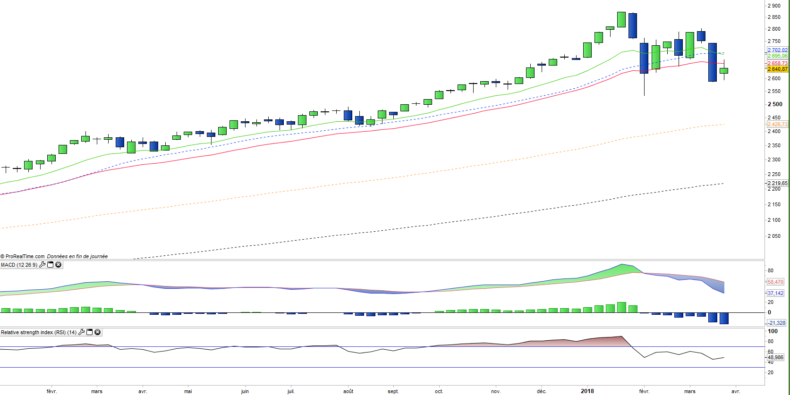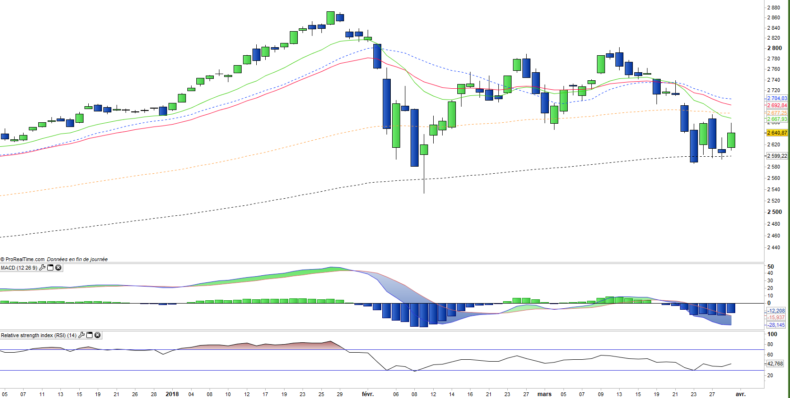SPDR S&P 500 (SPY) - 02/04/2018
Short Term strategy: Negative (20%) / Trend =
Long Term strategy: Positive (90%) / Trend -
Caractéristiques de l’ETF
The SPY ETF (SPDR) created in 01/1993 replicates the S & P 500 index, which is composed of the 500 main US stocks representative of the main sectors, while the stocks are selected according to the size of their market capitalization.
The ETF fees are quite low at 0.0945% and the AUM is $ 253bn. Replication is direct (physical) and there is a dividend distribution policy on a quarterly basis.
Alternative ETFS: AUM5 (Amundi in Euro), SP5 (Lyxor in Euro), IVV (iShares, in USD)
Latest developments
After an increase of 19.4% in 2017, and a sharp rise in January (+ 5.6%), the S & P500 suffered a sharp correction phase in February, then strongly relapsed after a rebound of a few weeks and posted now a decline of -1.2% since the beginning of the year.
This relapse was punctuated by announcements by the US administration on protectionist measures that target China in particular, but also on the Facebook user data scandal that affects the entire technology compartment.
However nothing seems lost, if rumors of trade negotiations with China are confirmed, while Facebook should get away with a significant but absorbable fine. The US index could continue its hesitation phase until the Q118 results to be published in 10 days and could allow a rebound if the expectations were to be exceeded. On the other hand, the technical configuration of the index is fragile and disappointments on the quaterly results could lead to a deepening of the correction.
Index & components
The top 10 stocks of the S & P500 include five major technology stocks (Apple, Amazon, Microsoft, Alphabet and Facebook), but also larger, more classic and iconic American companies such as JP Morgan or Exxon Mobil.
The main advantage of this index is its depth, which allows it to be a good proxy for the US economy, with a sector weighting that favors the growth sectors a little more, just like the technology stocks that represent about 25% of the weighting. Financials account for just under 15% of the index, and energy values of 6% are well balanced by defensive sectors such as health (about 14%) and consumer discretionary (13%).
The index has benefited from a strong momentum since the election of D. Trump, more than a year ago, while alongside the technology that remains the engine of the US market, new sectors have joined the trend, however a correction is now underway on the index because of fears of a return of inflation following the program of lower taxes for US businesses and households that should have a positive impact on growth, while announced deregulation on shale oil and banks could also benefit these sectors. However the multiples of the S & P 500 are currently quite high, even after the ongoing correction at around 19x the results at 12 months, which is at the top of range (historically between 15 and 20x) even if it must be put in American economy growth estimated at around 3% in 2018.
The whole question is now about the duration of the US cycle in a context of rising rates which is still progressive for the moment while the level of margins companies is at its highest level and seems to have lost much upside potential, even though the consensus is again on double-digit earnings growth in 2018 driven by the energy / oil sector, banks and technological values.
Weekly data
The weekly chart shows a weak upward reaction to the strong bearish candlestick of the previous week. However this figure forms a Harami, which is a weak bullish figure in this case because the second candlestick is located in the lower zone of the first one.
There is therefore a chance of recovery, but this figure must be confirmed to be validated. The index is below its EMA26 and moving averages are trending downward. The fate of the index will be played in the next few days, with for the moment an advantage for the bearish scenario in the short term.
Daily data
On the daily chart, we can visualize the rebound realized daily in contact with the EMA200 days which takes place as a major support in the short term. On the other hand, the reaction is too weak to change the technical situation as prices remain below the EMA13, 26 and 100 in the 2690pts area.
We must therefore monitor the direction of exit of this range of 2600/2700 pts which will decide the direction of the index in the coming weeks.
ETF Objective
SPY is an ETF listed in $, which seeks to replicate the S&P500 index (505 US companies)
Characteristics
| Inception date | 22/01/1993 |
| Expense ratio | 0.09% |
| Benchmark | S&P 500 |
| Issuer | SPDR |
| Ticker | SPY |
| ISIN | US78462F1030 |
| Currency | $ |
| Exchange | NYSE Arca |
| UCITS | Non |
| Assets Under Management | 254 957 M$ |
| Replication Method | Direct (Physical) |
| Dividend | Distribution |
| Currency risk | No |
| Number of Holdings | 505 |
| Risk | 3/5 |
Country Breakdown
| USA | 100% |
Sector Breakdown
| Information technology | 25% |
| Financials | 15% |
| Health Care | 14% |
| Consumer discretionary | 13% |
| Industrials | 10% |
| Consumer staples | 8% |
| Energy | 6% |
| Others | 9% |
Top Ten Holdings
| Apple | 4% |
| Microsoft Corp | 3% |
| Alphabet | 3% |
| Amazon | 3% |
| 2% | |
| JPMorgan Chase | 2% |
| Berkshire Hathaway | 2% |
| Johnson & Johnson | 2% |
| Exxon Mobil | 1% |


